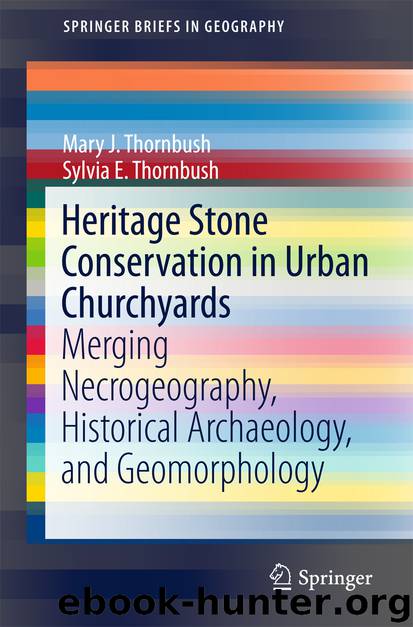Heritage Stone Conservation in Urban Churchyards by Mary J. Thornbush & Sylvia E. Thornbush

Author:Mary J. Thornbush & Sylvia E. Thornbush
Language: eng
Format: epub
Publisher: Springer International Publishing, Cham
Keywords
Urban churchyardsTransectBritish east coastSeriationEnglandScotland
This research project was instigated in 2006 by the second author (SE Thornbush) as part of her postgraduate research (at the University of Edinburgh, Scotland, UK). The original intent was to employ seriation as a methodology, as conveyed by Dethlefsen and Deetz (1966), in motif research based in New England cemeteries. This research revealed the cross-temporal change of motifs measured by counts of cherub and death’s-head motifs. As such, it represented an opportunity to quantitatively determine cultural changes (in popularity) of mortuary evidence demonstrative of burial rituals and preferences over time.
The study evolved, however, to also consider (besides cross-temporal cultural trends measurable by upright headstones and their properties) cross-temporal trends in headstone degradation and deterioration, and how this could affect the condition and integrity of the available record of legible headstone markers. The first author (MJ Thornbush) contributed to an examination of the weathering of headstones based on exposure in polluted urban environments, either inland or at the coast, in a variety of settings in England and Scotland. The entirety of the available cultural record, comprising legible headstones dating to years when the parish churches maintained active churchyards (up to the twentieth century), denotes the state of the art based on weathering forms (both additive, such as crusts and biological growths, and subtractive, chiefly constituting dissolving limestone exposed to acid pollution) and processes.
Different scales were considered, in addition to a variety of locations at interior and coastal sites, from the single headstone to churchyard to city to regional (country: England or Scotland) scales. When considered singly, headstones essentially represented landforms that are susceptible to cross-temporal change affected by physicochemical and biological weathering agents and processes. As such, headstones are affected more broadly by regional climate and specifically by urban climate , including microclimate. Due to continued exposure over time, these landforms are affected by the temperature and moisture regimes of their location, which establishes place-based variety in exposure leading to impacts on their condition and persistence. An effort is made to relay climatic information closest to the study sites, and these details appear from Chap. 6.
Download
This site does not store any files on its server. We only index and link to content provided by other sites. Please contact the content providers to delete copyright contents if any and email us, we'll remove relevant links or contents immediately.
The Vikings: Conquering England, France, and Ireland by Wernick Robert(79155)
Ali Pasha, Lion of Ioannina by Eugenia Russell & Eugenia Russell(39925)
The Vikings: Discoverers of a New World by Wernick Robert(36826)
The Conquerors (The Winning of America Series Book 3) by Eckert Allan W(36695)
Cecilia; Or, Memoirs of an Heiress — Volume 1 by Fanny Burney(32064)
Cecilia; Or, Memoirs of an Heiress — Volume 3 by Fanny Burney(31459)
Cecilia; Or, Memoirs of an Heiress — Volume 2 by Fanny Burney(31409)
Empire of the Sikhs by Patwant Singh(22769)
Hans Sturm: A Soldier's Odyssey on the Eastern Front by Gordon Williamson(18328)
The Secret History by Donna Tartt(18168)
Cat's cradle by Kurt Vonnegut(14763)
Sapiens: A Brief History of Humankind by Yuval Noah Harari(13993)
Pimp by Iceberg Slim(13781)
Talking to Strangers by Malcolm Gladwell(12881)
Norse Mythology by Gaiman Neil(12836)
Leonardo da Vinci by Walter Isaacson(12807)
Underground: A Human History of the Worlds Beneath Our Feet by Will Hunt(11840)
4 3 2 1: A Novel by Paul Auster(11794)
The Radium Girls by Kate Moore(11624)
